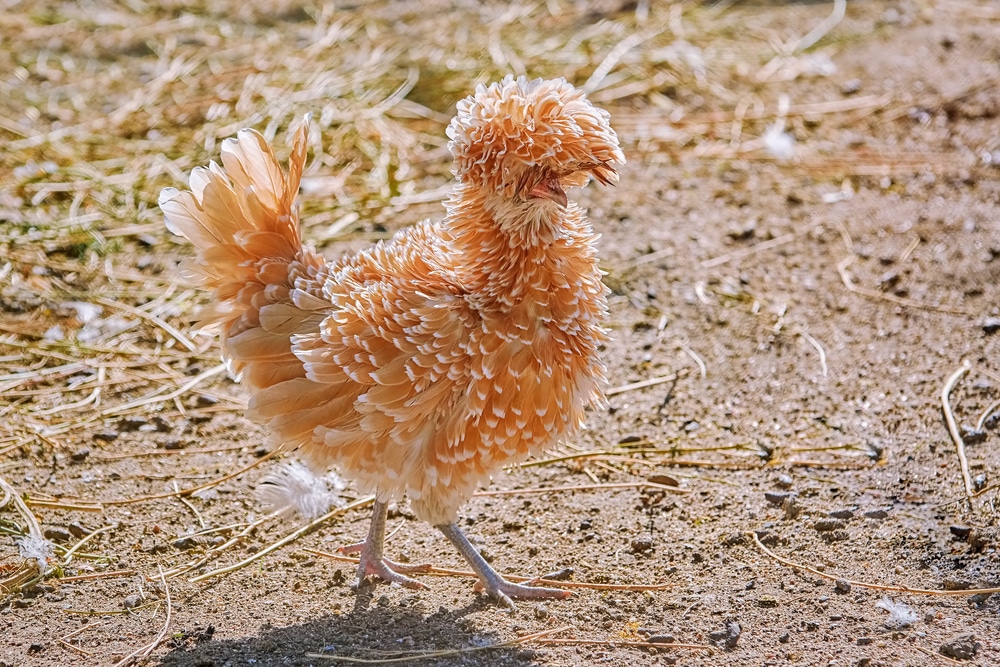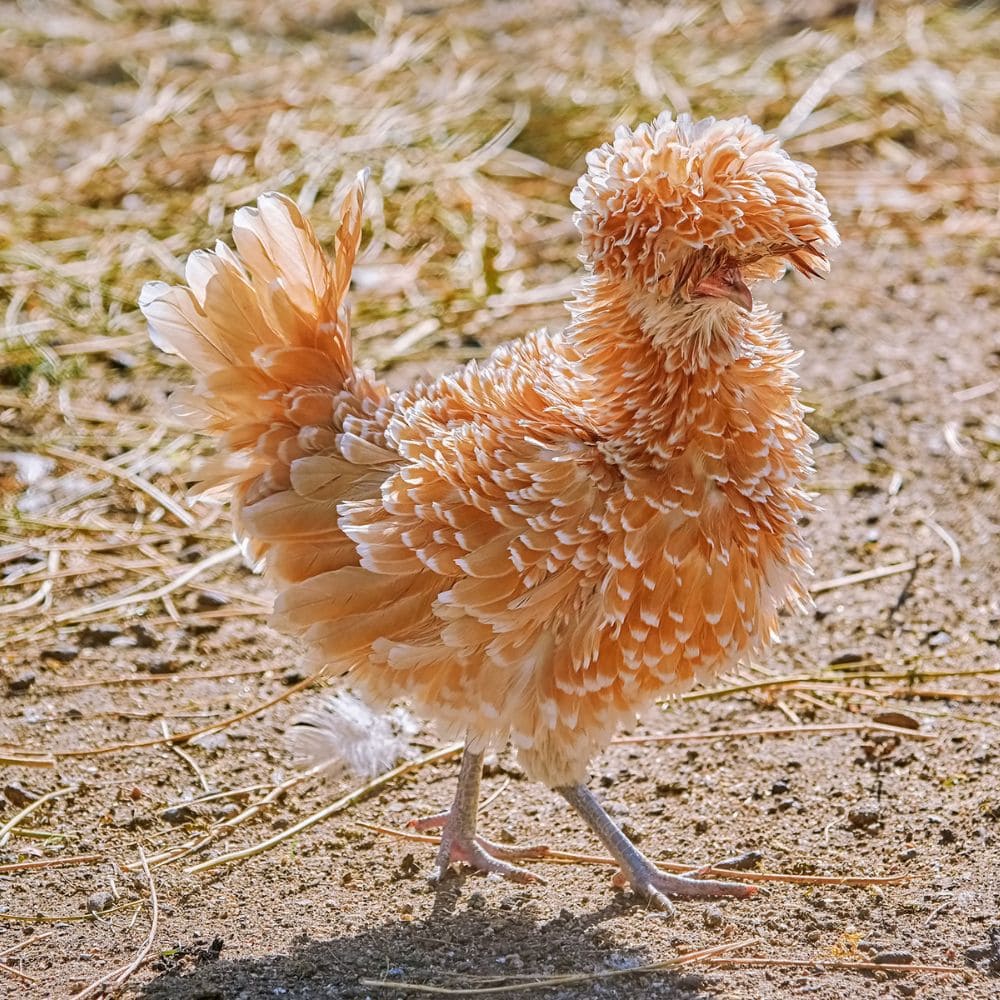Have you ever encountered a chicken that looks like it just stepped out of a salon with the most dramatic perm imaginable? That, my friends, is the captivating world of the Frizzle chicken, a breed whose whimsical appearance belies a fascinating history and a surprisingly adaptable nature.
The Frizzle chicken, a true testament to the marvels of avian genetics, is not a breed in the traditional sense, but rather a feather variant found across numerous established chicken breeds. This distinctive characteristic, the dramatic curl of the feathers, is caused by a dominant gene that affects the structure of the feather shaft, causing it to curl outwards instead of lying flat. This results in a plumage that appears fluffy, frizzy, and undeniably eye-catching. Their windswept appearance gives them a unique charm that has captivated poultry enthusiasts for generations, making them a popular choice for backyard flocks and poultry shows alike. The Frizzle's story is one of genetic curiosity, accidental discovery, and the enduring human fascination with the unique and the beautiful.
| Frizzle Chicken: Breed Overview | Details |
|---|---|
| Origin | A feather variant, not a specific breed; can be found within many existing breeds, their exact origins are difficult to pinpoint, though the "frizzle" gene has been present for centuries. |
| Appearance | Distinctive curled or frizzled plumage; feathers curl outward due to a genetic mutation; can come in a variety of colors depending on the underlying breed. |
| Temperament | Generally docile and friendly; known for being social and adaptable; can make good pets. |
| Egg Production | Egg production varies depending on the underlying breed of the Frizzle; some breeds are prolific layers, while others lay fewer eggs. They do tend to lay eggs in winter months, but it also depends on the breed as well. |
| Care Requirements | Similar to other chickens, but with some considerations due to their feathers. They might need extra protection from the elements. |
| Health Concerns | Prone to certain health issues due to the gene mutation; feathers can make them less resistant to cold and wet weather. |
| Genetics | The frizzled feather trait is caused by a dominant gene; breeding frizzles can produce more frizzles, but careful breeding is required to avoid health issues and over-frizzling. |
| Recognition | Frizzles are recognized as a feather variant by poultry organizations; show standards exist for specific breeds with the frizzled trait. |
| Breeding | Breeding a Frizzle with a Frizzle will result in 100% Frizzle chicks if they have the Frizzle gene. They can be crossed with other breeds. |
| Types | Frizzles are not a breed but a feather variety seen across many breeds, including but not limited to: Cochins, Polish, and Japanese Bantams, resulting in different sizes, colors, and body types. |
| Show and backyard flock | They can be shown in poultry shows and can be kept in backyard flocks. |
| Reference Website | Backyard Chickens - Frizzle Chicken Breed Information |
The history of the Frizzle chicken is a bit like a feathered mystery. Since the frizzle gene is dominant, it can appear unexpectedly in the offspring of various breeds. There isn't a single "birthplace" for the Frizzle; instead, the trait seems to have popped up independently in different locations and chicken varieties over time. It's a story of genetic chance meeting human curiosity. Because the frizzle trait can occur in any breed, it has been around for centuries. However, the development of the Frizzle as a recognized feather variant, especially in poultry shows, is a more recent phenomenon, reflecting the growing appreciation for unique and beautiful poultry.
The appearance of the Frizzle chicken is, without a doubt, its most striking feature. The defining characteristic, of course, is the plumage. The feathers are curled, often dramatically so, giving the bird a fluffy, windswept look. The degree of curl can vary, from a subtle wave to a near-complete backward curl. This is due to the genetic mutation that affects the keratin structure of the feather, causing it to bend rather than lie flat. The effect is a chicken that looks perpetually tousled, as if it's just stepped out of a wind tunnel or a very enthusiastic grooming session. It also looks like they are fluffy and frizzy as mentioned before.
The appearance also depends on the underlying breed. Frizzles come in a wide array of colors, sizes, and body types, depending on the specific breed in which the frizzle gene manifests. You might find Frizzles in the elegant, compact form of a Japanese Bantam, the robust build of a Cochin, or the crested head of a Polish chicken. This diversity means that Frizzles offer a variety of visual appeal. They can be found in various colors, from the classic white or black to the more vibrant hues of blue, buff, or even speckled patterns. Some frizzles exhibit a condition called "over-frizzling," where the feathers become brittle and break easily. This is why responsible breeding practices are essential when working with this unique feather variant.
Beyond their eye-catching appearance, Frizzle chickens are often praised for their friendly and social temperament. They tend to be docile, making them a good choice for backyard flocks, especially if you have children. They can be quite inquisitive and enjoy interacting with their human caretakers. These birds are known for their charming personalities, brightening up any backyard with their playful antics and unique appearance. However, as with any breed, individual personalities can vary. Early socialization and consistent, positive interactions are key to fostering a well-adjusted and friendly flock.
Raising Frizzle chickens requires some consideration due to their unique feather structure. Their curled feathers offer less insulation than the flat feathers of other breeds, making them more susceptible to cold weather and heat. They also tend to be more susceptible to injuries and scratches. Therefore, providing adequate shelter from the elements is essential. A well-ventilated coop, protected from drafts and extreme temperatures, is crucial for their well-being. In colder climates, extra bedding and supplemental heat may be necessary. In hot weather, ensure they have plenty of shade and access to fresh, cool water to prevent overheating.
While Frizzles can typically forage for food, their plumage might make it difficult to navigate dense undergrowth. Providing a balanced diet is essential for their health. A standard chicken feed, supplemented with fresh greens, fruits, and vegetables, will provide the necessary nutrients. Always ensure they have access to clean water. Its crucial to monitor the flock for any signs of health problems, such as respiratory issues (related to feather structure and susceptibility to the elements), mites or lice (which can be more difficult to detect due to the curled feathers), or any other signs of illness. Regular health checks and prompt veterinary attention are essential.
The egg production of Frizzle chickens is directly related to the breed they are derived from. If a Frizzle is a variation of a prolific laying breed, like the Leghorn, they will generally lay a good number of eggs. If they are a variant of a breed known for moderate egg production, the Frizzle will reflect that. The breed will also determine the size and color of the eggs. Some Frizzles lay large brown eggs, while others lay smaller, tinted eggs. Breeding practices, health, and environmental factors also play a role in egg production, with the winter months having less egg production.
Breeding Frizzle chickens can be an interesting endeavor. Because the frizzle gene is dominant, breeding a Frizzle with another Frizzle typically results in a high percentage of frizzle offspring. However, breeding practices should prioritize the health and well-being of the birds. The offspring should be considered. Over-frizzling, where the feathers become excessively curled and brittle, can be a concern. Some breeders choose to breed Frizzles with non-frizzled birds (often called "smooth-feathered" birds) to introduce genetic diversity and potentially mitigate over-frizzling, resulting in a 50% chance of frizzle chicks. This allows for a focus on other desirable traits, such as good egg production, temperament, and overall health. Selecting healthy, well-feathered birds for breeding is crucial to producing strong, vibrant offspring.
Showing Frizzle chickens in poultry shows can be an exciting opportunity to showcase the breed's unique characteristics. Each breed will have a different standard, but the most common focus will be on feather quality. Show standards often prioritize feather quality, body type, and overall appearance. Before entering a show, it is important to research the specific breed standards for the Frizzle chicken being shown. This will ensure that the birds meet the criteria and are in the best possible condition. Preparation involves grooming the birds, ensuring they are free of parasites, and practicing with them to get them accustomed to being handled. It also helps to get the birds used to being judged. The dedication and care that goes into raising a Frizzle chicken can be handsomely rewarded in the show ring.
Finding Frizzle chickens can be done through various avenues. Hatcheries often offer Frizzle chicks, particularly those that specialize in heritage breeds. Online poultry forums and breeder directories can be a great way to connect with reputable breeders in your area. Local poultry clubs and agricultural fairs can provide opportunities to meet breeders and see Frizzles in person. When purchasing, assess the birds' health, feather quality, and overall condition. It is also good to ask the breeder questions about their breeding practices and the history of the birds.
One of the most fascinating aspects of the Frizzle chicken is the genetic condition that creates their unique appearance. The curling of the feathers is caused by a dominant gene, which alters the structure of the feather shaft. The result is a feather that bends outwards. The gene's dominance means that a single copy of the gene is enough to express the frizzle trait. There are a lot of types of Frizzle chickens.
In different countries, the recognition of Frizzle chickens varies. They're widely recognized and appreciated as a feather variant by poultry organizations in many countries, and show standards exist for specific breeds with the frizzle trait. However, in some regions, they may be less common. Poultry shows and breeder communities often play a significant role in promoting and preserving the breed.
Beyond their distinctive appearance, breeding Frizzles with other breeds can result in beautiful offspring with unique features and characteristics, offering a way to create new variations and further explore the possibilities within the poultry world. The Frizzle chicken's unique appearance has led to its popularity as a pet chicken.
In conclusion, the Frizzle chicken is a unique and charming breed that is a true delight to keep. It is a fun and enjoyable addition to any backyard flock. Their unique appearance and friendly personalities make them a favorite among chicken enthusiasts.


